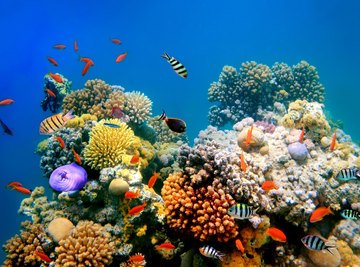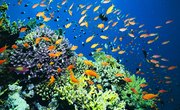
Aquatic ecosystems consist of interacting organisms that use each other and the water they reside in or near for nutrients and shelter. Aquatic ecosystems are divided into two major groups: marine, or saltwater, and freshwater, sometimes called inland or nonsaline. Each of these can be further subdivided, but the marine types are more typically grouped together than the freshwater ecosystems.
The Largest Ecosystem
Oceans are the largest of the ecosystems, covering more than 70 percent of the Earth's surface. The ocean ecosystem is divided into four distinct zones. The deepest zone of this marine ecosystem, the abyssal zone, has cold, highly-pressurized water with high oxygen but low nutrient levels. Ridges and vents on the ocean floor that emit hydrogen sulfide and minerals are found in this zone. Above the abyssal zone is the benthic zone, a nutrient-rich layer that contains seaweed, bacteria, fungi, sponges, fish and other fauna. Above this is the pelagic zone, essentially the open ocean, which features water with a broad temperature range, surface seaweeds and many species of fish as well as some mammals. The intertidal zone, where the ocean meets land, is covered by water during high tide and is terrestrial during low tide, allowing it to support unique vegetation and animal life.
Rainforests of the Sea
Coral reefs cover only a tiny fraction of the Earth's surface and only a slightly larger percentage of the ocean bottom but support a great deal of diverse aquatic life. Reef-building corals exist only in shallow subtropical and tropical waters. The corals host photosynthesizing algae and get most of their food from these algae, allowing for enough growth to form large structures that create valuable habitat. Rising water temperatures and increasing acidification of water linked to increases in carbon dioxide are the greatest threats coral reefs face. On local levels, over-harvesting of coral and overfishing threatens reefs, as do invasive species and polluted runoff.
Looking at Shorelines
Like coral reefs, estuaries are sometimes grouped with oceans to make up the marine ecosystem. Estuaries occur where saltwater from the ocean and freshwater flowing from rivers or streams meet, creating a unique habitat oriented around water that has a varied salt concentration and has high levels of nutrients resulting from sediments being deposited by rivers or streams.
Lakes and Ponds
Lakes and ponds, water bodies with varied surface areas and volumes, are also known as lentic ecosystems and are characterized by a lack of water movement. Like oceans, lakes and ponds are divided into four distinct zones: littoral, limnetic, profundal and benthic. Light penetrates the uppermost of these, the littoral, which contains floating and rooted plants. The other zones also each play unique roles in the ecosystem.
Flowing Freshwater
Rivers, streams and creeks are classified as lotic ecosystems. These ecosystems are characterized by flowing freshwater, which moves to a larger river, lake or ocean, and is present during part or throughout all of the year. Because of the water's movement, rivers and streams tend to contain more oxygen than their lentic relatives and have host species that are adapted to the moving water.
Wet Soils and Water-Loving Plants
Wetlands are freshwater ecosystems characterized by the presence of water, which could be several feet deep or simply saturate the soil, often with seasonal fluctuations. Certain types of soil known as hydric soils that are different than other soils and plant species adapted to wet conditions also characterize wetlands. Wetlands are very important in regulating water levels, filtering water and improving water quality, reducing flood dangers and providing valuable habitat for plants and animals.
About the Author
Angela Ryczkowski is a professional writer who has served as a greenhouse manager and certified wildland firefighter. She holds a Bachelor of Arts in urban and regional studies.
